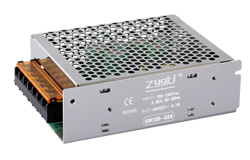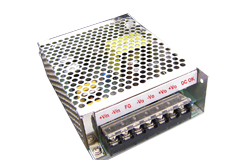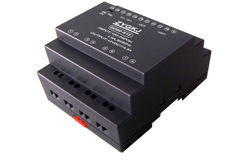news
Building a 120 Volt AC Power Supply for 3 Volts DC
Author: ZYG Power Module Time: 2023-4-18
Introduction:
In this article, we will discuss how to build a 120-volt AC power supply for 3 volts DC. This process requires some basic knowledge of electronics and safety measures. We will provide step-by-step instructions to help guide you through the process.
Materials Required:
– Transformer (120V to 12V AC)
– Bridge rectifier
– Capacitor (1000uf, 16V)
– Voltage regulator (LM7803)
– Heat sink
– Wires
– Soldering iron and solder
– Wire stripper
– Pliers
– Safety glasses
Step 1: Safety Precautions
Before starting any electrical project, it is essential to take safety precautions to avoid electrical shocks or fires. Wear safety glasses to protect your eyes from soldering fumes. Ensure that the circuit is unplugged from the power source when assembling or testing.
Step 2: Assembling the Circuit
The first step in building a 120-volt AC power supply for 3 volts DC is assembling the circuit. This process involves connecting the transformer, bridge rectifier, capacitor, voltage regulator, and heat sink. Follow the wiring diagram to connect the components correctly.
Step 3: Wiring the Transformer
The transformer is the first component to connect. It converts 120 volts AC to 12 volts AC, which is then rectified to DC. Cut the wires of the transformer to the required length using a wire cutter. Strip the ends of the wires using a wire stripper to expose the copper strands. Connect the wires to the terminals of the transformer according to the wiring diagram.
Step 4: Wiring the Bridge Rectifier
The bridge rectifier is used to convert AC to DC. Connect the bridge rectifier to the transformer using the wires provided. Ensure that the polarity is correct by following the wiring diagram.
Step 5: Wiring the Capacitor
The capacitor is used to smooth out the DC voltage, reducing any ripples or fluctuations. Connect the capacitor to the bridge rectifier using the wires provided. Ensure that the polarity is correct by following the wiring diagram.
Step 6: Wiring the Voltage Regulator
The voltage regulator is used to regulate the voltage to 3 volts DC. Connect the voltage regulator to the capacitor using the wires provided. Ensure that the polarity is correct by following the wiring diagram.

Step 7: Installing the Heat Sink
The voltage regulator generates heat during operation. Installing a heat sink helps to dissipate the heat away from the regulator, preventing damage. Attach the heat sink to the voltage regulator using screws or thermal glue.
Step 8: Testing the Circuit
Before powering the circuit, it\’s essential to check for any wiring errors or shorts. Use a multimeter to test the circuit\’s continuity and resistance. Once you\’re satisfied, plug in the circuit to a 120-volt AC power source and check the output voltage using a multimeter. The output voltage should be 3 volts DC.
Conclusion:
Building a 120-volt AC power supply for 3 volts DC requires some basic electronics knowledge and safety measures. Follow the wiring diagram and steps provided to assemble the circuit correctly. Test the circuit for any errors or shorts before plugging it into a power source. Once you satisfied, you should have a functioning power supply that produces 3 volts DC.
Precedente: how to wire ac to dc power supply
informazioni rilevanti
-
2023-7-6
Introducing the SPM Series: An AC DC Converter for All Your Power Conversion Needs
In today's fast-paced world, reliable and efficient power conversion is a crucial factor in ensuring the smooth operation of various electrical devices and systems. Whether it's for industrial applications, telecommunications, or renewable energy sources, having a high-quality AC DC converter is essential. That's where the SPM Series comes in. The SPM Series is a cutting-edge AC DC converter designed to meet all your power conversion needs. With its advanced technology and robust features, this converter stands out from the competition, providing unparalleled performance and reliability. One of the key features of the SPM Series is its versatility. This converter is capable of converting both alternating current (AC) and direct current (DC) power sources, making it suitable for a wide range...
Visualizza dettagli -
2023-6-3
Exploring the functionality and advantages of bidirectional converters
In today's world of electronics, the need for efficient power management is rapidly increasing. With the growing demand for renewable energy sources, bidirectional converters have become a crucial component in energy storage systems, electric vehicles, and microgrids. Bidirectional converters are devices that can convert DC power into AC power and vice versa. They are designed to be able to transfer power in both directions, making them highly versatile and essential in applications that require efficient power management. Bidirectional converters can be classified into two types: AC-DC and DC-DC converters. AC-DC converters are used to convert AC power to DC power, while DC-DC converters convert DC power to DC power. The main advantage of bidirectional converters is their ability to transfer...
Visualizza dettagli -
2023-5-21
Efficiently Power Your Devices with our 120V AC to 12V DC Converter
Are you tired of constantly having to replace batteries or deal with messy cords and chargers? Our 120V AC to 12V DC converter is the solution you've been looking for. This converter allows you to efficiently power your devices that require 12 volts DC with the standard 120 volts AC power found in most households. Simply plug the converter into a wall outlet and connect your device to the converter. No more worrying about dead batteries or messy cords! Our converter is compact and lightweight, making it easy to take with you on the go. It's perfect for powering devices while traveling or camping. Plus, the durable construction ensures it will withstand the wear and tear of daily use. The...
Visualizza dettagli -
2023-5-8
Designing an AC-DC Converter Circuit: A Step-by-Step Guide
Introduction An AC-DC converter circuit is an electrical circuit that is used to convert alternating current (AC) to direct current (DC) voltage. This converter circuit is commonly used in electronic devices such as computers, televisions, and audio equipment. The AC-DC converter circuit design can be complex, and it requires a good understanding of electronic circuits, components, and their properties. In this article, we will provide a step-by-step guide to designing an AC-DC converter circuit. Step 1: Determine the Required Voltage and Current The first step in designing an AC-DC converter circuit is to determine the required voltage and current for your application. This will depend on the electronic device that you are designing the circuit for. For example, a computer...
Visualizza dettagli -
2023-4-16
Generating DC Power: Understanding AC-DC Converters
In today world, electricity is a crucial part of our daily lives. Everything from our homes to our workplaces to our smartphones is powered by electricity. But not all devices are powered by the same type of electricity. Some devices require direct current (DC) power, while others require alternating current (AC) power. AC power is the type of electricity that is delivered to most homes and businesses. It is called alternating current because it switches direction many times per second, typically 60 times in the United States. In contrast, DC power flows in one direction only. AC-DC converters are devices that transform AC power into DC power. They are used in a wide range of applications, from powering electronic devices...
Visualizza dettagli -
2023-8-2
Cheap Medical Power Series: Empowering Healthcare Professionals through Innovation and Knowledge
Introduction In an ever-evolving field like healthcare, it is crucial for healthcare professionals to stay updated with the latest advancements and innovations. The Medical Power Series aims to empower healthcare professionals by providing them with access to cutting-edge technologies, knowledge, and expertise. This article explores how the Medical Power Series is transforming the healthcare industry and equipping professionals with the tools they need to deliver the best possible care to their patients. I. Innovative Technology The Medical Power Series is at the forefront of incorporating innovative technologies into healthcare practices. From wearable devices that monitor vital signs to telemedicine platforms that enable remote consultations, the series ensures that healthcare professionals have access to state-of-the-art tools. These technologies not only enhance...
Visualizza dettagli


















